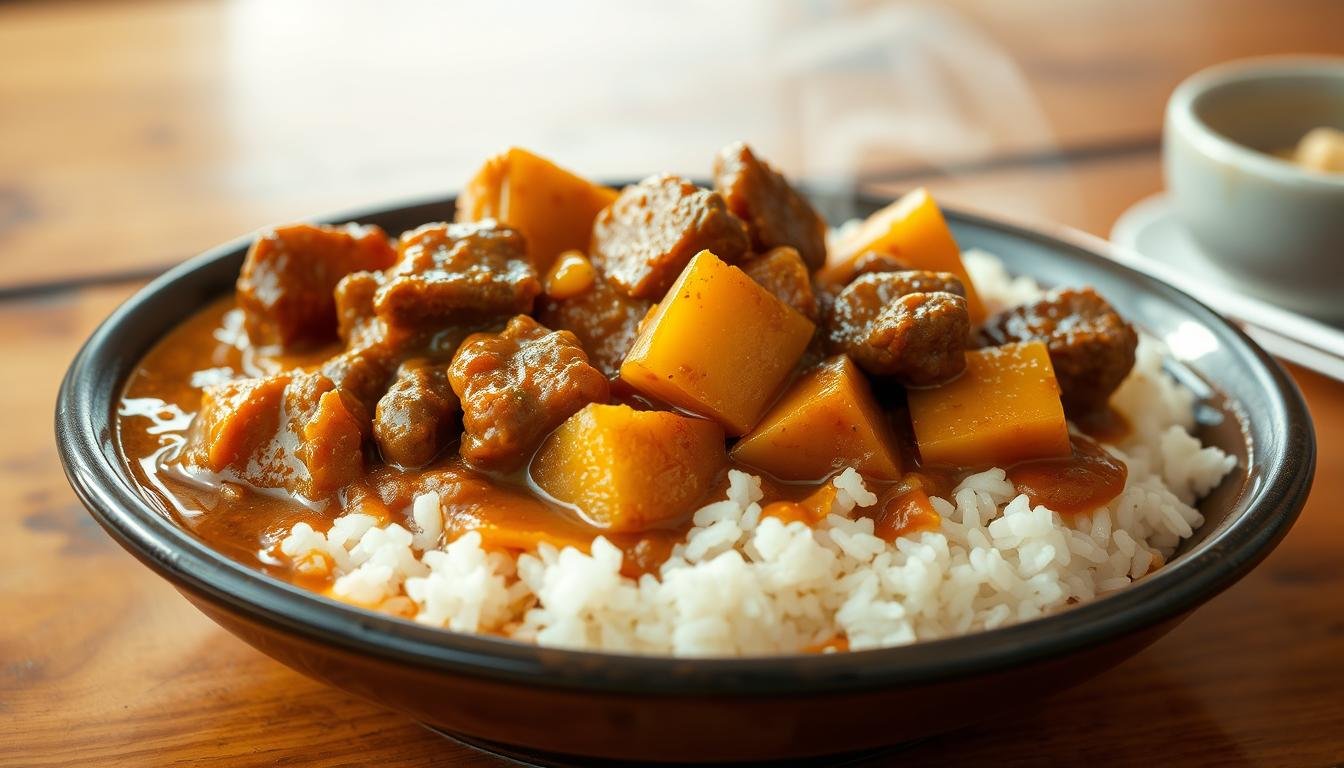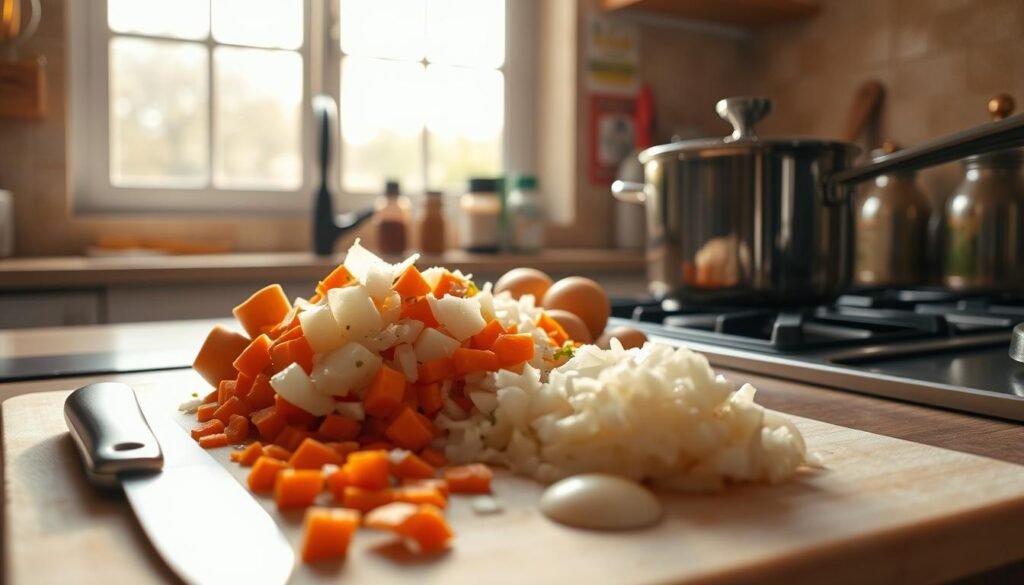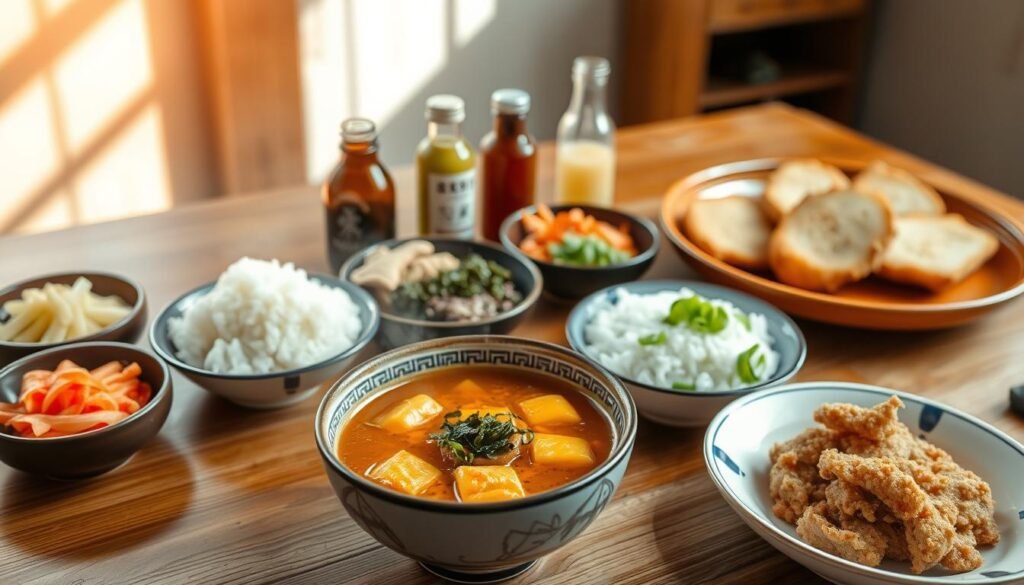Easy Homemade Japanese Curry Recipe: Perfect Comfort Food

Do you know the joy of returning home tired, craving something warm? For me, that’s Japanese curry. Cooking this simple curry rice brings back cozy evenings. The smell of spices is calming. It’s not just food—it’s a step into peace and fond memories.
Creating homemade Japanese curry is hugely satisfying. Hearing the vegetables sizzle and smelling the spices is blissful. Every step makes me happy. I promise, this easy Japanese curry will become your favorite too.
Why Everyone Loves Japanese Curry — Introduction
Hey there, fellow food lovers! Ever wondered why Japanese curry is loved all over? You’re not alone! It’s the ultimate Japanese comfort food, warming the soul and exciting the taste buds. Its rich flavor and smooth texture make it super popular. You can find out more about it here!
What’s so special about it? Japanese curry has a unique spice mix. It’s comforting and perfect for any time. It’s milder than other curries, so even if you don’t like spicy food, you’ll enjoy it. It’s wonderful with rice, noodles, or in curry bread.
Why is Japanese curry amazing? It’s easy to make. Perfect for all cooks, from newbies to pros. With some simple ingredients and patience, you can make a tasty meal. And the smell while it cooks is incredible!
If you want a dish that’s both yummy and simple, try Japanese curry. It satisfies hunger and brings people together. Isn’t that what great food does?
What Makes Japanese Curry Unique?
Japanese curry is a mix of tastes unlike any other curry. It came to be special because of its Origins & Evolution of Japanese Curry. The British first brought it over in the late 1800s. Then, it changed to match what people in Japan liked. Now, it’s thick, savory, and a bit sweet.
In the 1950s, S&B Foods made a big change with curry roux blocks. This made it easy for anyone to cook curry at home. Thanks to this, the Origins & Evolution of Japanese Curry could grow in Japan.
What really makes Japanese curry stand out? It’s the sweet taste from apples, honey, and spices. It’s not as spicy as curries from India or Thailand but still full of flavor. This sweetness and its comforting texture have made it a favorite in Japan and the world!

Essential Ingredients and Equipment
Let’s start making Japanese curry with the right stuff. This includes meats, vegetables, spices, and the kitchen tools you need.

Picking the right meats and vegetables is key. Boneless, skinless chicken breasts are tender and tasty. Add vegetables like carrots, potatoes, and green bell peppers for sweetness and depth.
For a true Japanese curry, spices are crucial. You need:
– 4 teaspoons coriander seeds
– 1 tablespoon fenugreek seeds
– 2 ½ teaspoons cumin seeds
– 1 ½ teaspoons green cardamom pods
– ¼ teaspoon fennel seeds
– ½ teaspoon whole cloves
– ⅛ teaspoon ground star anise
– ⅛ teaspoon cinnamon stick
– 5 teaspoons ground turmeric
– ½ teaspoon white peppercorns
– ½ teaspoon black peppercorns
– ⅛ teaspoon ground allspice
– ⅛ teaspoon ground nutmeg
Wondering about curry roux? Homemade or store-bought? With homemade roux, you control the flavor and what goes in it. Our guide to homemade curry roux can help you make it.
You also need the right pots and tools. Get a skillet, a grinder or blender, a saucepan, a big pot, and a spoon for stirring.
Pick meats and vegetables you like for your curry. This way, it will be special to you. With these basics, your cooking adventure can begin!
Ready for a cooking adventure? Let’s make your dream curry!
Step-by-Step Japanese Curry Recipe

Start making Japanese curry by prepping ingredients. First, peel and chop onions. Cook them till they’re golden. This brings out a sweet taste. Next, mix in minced ginger and garlic for a deep aroma. This is what makes it taste like authentic Japanese food.
Then, it’s time to cook your choice of meat. You can choose from chicken, beef, or pork. Cooking the meat till it’s brown keeps it juicy. This gives the curry a deep flavor. After browning the meat, put in chunky vegetables like carrots and potatoes. This mix of meat and veggies is perfect in every bite.
Now, add some chicken stock to make your curry rich. Here’s a special step: use an apple-infused roux. This roux adds a slight sweetness, making your curry even more special!
After putting in the roux, let everything simmer. Take your time with this. Letting it simmer mixes all the flavors well. This turns simple ingredients into a thick, delicious sauce. Trust me, being patient here is worth it.
To make it easy, here’s a table with the steps:
| Steps | Details |
|---|---|
| 1. Prep Ingredients | Chop onions, cube meat, cut vegetables |
| 2. Sauté Onions | Golden-brown for sweetness |
| 3. Add Aromatics | Ginger and garlic |
| 4. Brown Meat | Chicken, beef, or pork |
| 5. Add Veggies | Carrots and potatoes |
| 6. Pour Stock | Brick chicken stock for richness |
| 7. Infuse Roux | Apple-infused for sweetness |
| 8. Simmer | Until all flavors meld together |
By following these steps, your Japanese curry will be amazing. It’s rich, tasty, and perfect for a cozy night. Now, doesn’t that sound delicious?
Variations & Toppings
Japanese curry is amazingly versatile! Traditional versions may use beef like short ribs or pork belly. But you can also find vegetarian & vegan versions with tofu or veggies. These options are tasty and good for you.
Want to learn more about making Japanese curry? Check out this detailed guide on Japanese curry roux cubes. It offers expert advice and breaks down ingredients!
Adding your own twist? Try different toppings. Melty cheese or fukujinzuke (pickled vegetables) can change the game. They add creaminess or a crunchy, zesty kick.

Looking for something crunchy? Add a crispy katsu on top. Choose from chicken katsu curry or tonkatsu (pork cutlet). Karaage (Japanese fried chicken) is another great option.
Ever thought about using seasonal veggies? Summer calls for eggplant and zucchini. Winter is great for sweet potatoes and napa cabbage. They make your curry colorful and cozy, no matter the season.
Creating vegetarian & vegan dishes? Try okra, pumpkin, or spinach. Japanese curry lets you be creative. Every dish can be unique, full of taste and excitement.
Tips for the Best Japanese Curry Ever
Want delicious Japanese curry every time? Master a few key tricks. To thicken curry perfectly, balance liquid and roux is key. Add the roux gradually and stir well to get the right thickness.

Add Worcestershire sauce or garam masala for more flavor. Here’s a table with some Japanese curry hacks:
| Technique | Benefit |
|---|---|
| Adding Roux Gradually | Achieves Perfect Thickness |
| Using High Spice Level Roux | Enhances Spiciness |
| Adding Worcestershire Sauce | Deepens Flavor |
| Sprinkling Garam Masala | Enriches Aroma |
Trying to thicken curry or boost flavors? These tips make you cook like a pro. Enjoy cooking and have fun!
Serving & Storing Japanese Curry
Japanese curry is the ultimate comfort food, making mealtime special. Ideally, pour the curry over steamed short-grain rice. The flavors blend perfectly this way. Want to make it better? Add pickles or a hard-boiled egg for taste and beauty.

Choosing the Best Side Dishes makes your curry stand out. Consider a crisp green salad, steamed edamame, or miso soup. Proper Presentation turns your home-cooked curry into a feast for the eyes!
Storing your curry is simple. Use the fridge for short-term storage. Seal it well to keep the flavors fresh. For longer storage, freezing works best. It keeps the curry yummy for weeks!
Reheat your curry carefully to keep its taste. Warm it on low heat, stirring often. If the sauce gets too thick, add water. This keeps it just as good as when first made.
Focusing on Best Side Dishes & Presentation boosts enjoyment. It makes your meal visually appealing and delicious. Treat yourself, and you’ll love it!
Wrapping It All Up: Make Japanese Curry Tonight!
Ready to make Japanese curry? It’s very easy and rewarding. Japanese curry has a special taste. It’s creamy and full of spices. You know what you need and how to cook it. Isn’t that exciting?
We talked about how to make your curry your own. You can use chicken or seafood, and more! Don’t forget my extra tips. They help make the best curry. Adding soy sauce or letting it simmer will make it even better.
And after making your curry, know how to keep it. You can chill or freeze what’s left for another day. Imagine a quick tasty dinner waiting for you!
So, start cooking! Get your stuff, put on your apron, and cook Japanese curry tonight! It’s a dinner idea everyone will love. Happy cooking!